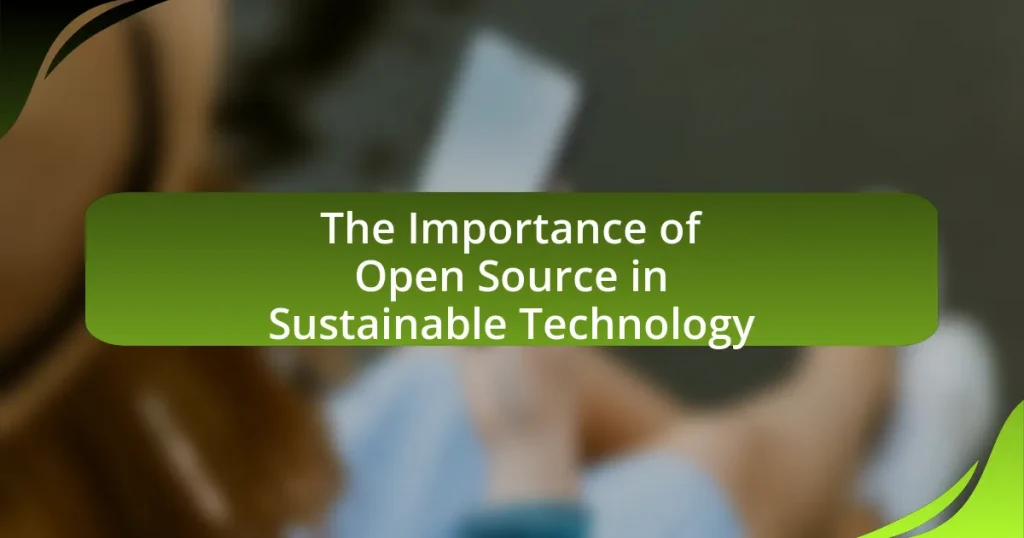Open source plays a vital role in the development of the Internet of Things (IoT) by providing accessible software and hardware resources that promote innovation and collaboration among developers. Key principles such as transparency, community-driven development, and collaboration enhance the security and functionality of IoT solutions. The article explores how open source contributes to the growth of IoT, addresses security challenges, and highlights economic benefits, while also discussing common misconceptions and risks associated with its adoption. Additionally, it examines future trends and best practices for developers in the open source IoT landscape.

What is the Role of Open Source in IoT Development?
Open source plays a crucial role in IoT development by providing accessible software and hardware resources that foster innovation and collaboration. This accessibility allows developers to modify and improve existing technologies, leading to faster advancements in IoT solutions. For instance, platforms like Arduino and Raspberry Pi have enabled countless projects by offering open-source hardware and software, which has significantly reduced development costs and time. Additionally, open-source communities contribute to security improvements and bug fixes, enhancing the reliability of IoT devices. According to a 2021 report by the Linux Foundation, 90% of organizations in the IoT space utilize open-source software, highlighting its integral role in driving the industry forward.
How does open source contribute to the growth of IoT?
Open source contributes to the growth of IoT by enabling collaborative development, which accelerates innovation and reduces costs. This collaborative environment allows developers and companies to share code, tools, and resources, leading to faster prototyping and deployment of IoT solutions. For instance, platforms like Arduino and Raspberry Pi provide open-source hardware and software, fostering a community that drives advancements in IoT applications. According to a report by the Linux Foundation, 90% of IoT projects utilize open-source software, highlighting its critical role in the ecosystem. This widespread adoption demonstrates how open source not only enhances interoperability among devices but also encourages a diverse range of applications, ultimately propelling the growth of IoT.
What are the key principles of open source that apply to IoT?
The key principles of open source that apply to IoT include transparency, collaboration, and community-driven development. Transparency ensures that the source code is accessible, allowing developers to inspect, modify, and improve the software, which is crucial for security and reliability in IoT devices. Collaboration fosters innovation as developers from diverse backgrounds contribute to projects, enhancing functionality and addressing various use cases. Community-driven development emphasizes the importance of user feedback and contributions, leading to more robust and user-centric IoT solutions. These principles collectively promote a more secure, adaptable, and innovative IoT ecosystem.
How does open source foster collaboration in IoT projects?
Open source fosters collaboration in IoT projects by providing a shared platform where developers can contribute, modify, and enhance code collectively. This collaborative environment encourages innovation and accelerates development, as seen in projects like Arduino and Raspberry Pi, which have large communities that share resources and knowledge. The transparency of open source allows for peer review and rapid iteration, leading to higher quality and more secure IoT solutions. Additionally, studies show that open source projects often attract diverse contributors, which enhances creativity and problem-solving capabilities, further driving the success of IoT initiatives.
Why is open source important for IoT security?
Open source is important for IoT security because it enables transparency and community collaboration, which are essential for identifying and mitigating vulnerabilities. By allowing developers and security experts to inspect, modify, and enhance the code, open source projects can rapidly address security flaws that proprietary systems may overlook. For instance, the Open Web Application Security Project (OWASP) has highlighted that open source software often benefits from a larger pool of contributors who can spot and fix security issues more quickly than closed-source alternatives. This collaborative approach leads to more robust security measures and fosters trust among users, as they can verify the integrity of the software they are using.
What security challenges does IoT face that open source can address?
IoT faces several security challenges, including device vulnerabilities, lack of standardization, and inadequate security updates. Open source can address these challenges by providing transparent code that allows for community scrutiny, enabling faster identification and patching of vulnerabilities. For instance, the Open Web Application Security Project (OWASP) has developed guidelines specifically for IoT security, promoting best practices that can be implemented in open source projects. Additionally, open source platforms facilitate collaboration among developers, leading to the creation of standardized security protocols that enhance overall IoT security.
How do open source tools enhance IoT security measures?
Open source tools enhance IoT security measures by providing transparency, community-driven development, and rapid vulnerability response. Transparency allows developers and security experts to inspect the source code for vulnerabilities, leading to more robust security practices. Community-driven development fosters collaboration among a diverse group of contributors, which can lead to the identification and patching of security flaws more quickly than proprietary solutions. For instance, the Open Web Application Security Project (OWASP) provides resources and tools that help developers secure IoT applications by addressing common vulnerabilities. Additionally, open source tools often have a larger user base that contributes to ongoing security assessments, ensuring that potential threats are identified and mitigated promptly.
What are the economic benefits of using open source in IoT?
The economic benefits of using open source in IoT include reduced development costs, increased innovation, and enhanced collaboration. Open source software eliminates licensing fees, allowing companies to allocate resources more efficiently, which can lead to significant cost savings. For instance, a study by the Open Source Initiative found that organizations using open source technologies reported a 20-30% reduction in software development costs. Additionally, open source fosters innovation by enabling developers to build upon existing code, accelerating the development of new features and applications. This collaborative environment also encourages knowledge sharing, which can lead to faster problem-solving and improved product quality. Overall, the adoption of open source in IoT not only lowers expenses but also drives technological advancement and community engagement.
How does open source reduce costs in IoT development?
Open source reduces costs in IoT development by eliminating licensing fees and enabling collaborative innovation. By utilizing open source software and hardware, developers can access a wealth of pre-existing resources, which significantly lowers the initial investment required for projects. For instance, a study by the Linux Foundation found that companies using open source technologies can save up to 30% on development costs compared to proprietary solutions. This cost reduction is further amplified by the community-driven support and continuous updates that open source projects receive, allowing for faster problem resolution and feature enhancements without incurring additional expenses.
What impact does open source have on innovation in IoT?
Open source significantly accelerates innovation in IoT by providing accessible resources and collaborative frameworks for developers. This collaborative environment fosters rapid prototyping and experimentation, enabling companies to leverage shared knowledge and tools, which reduces development time and costs. For instance, platforms like Arduino and Raspberry Pi have democratized hardware access, allowing a diverse range of innovators to create IoT solutions. Additionally, studies show that open source projects in IoT can lead to faster deployment of new technologies, as seen in the widespread adoption of protocols like MQTT and CoAP, which are open standards that facilitate interoperability among devices.

What are the Challenges of Open Source in IoT Development?
The challenges of open source in IoT development include security vulnerabilities, lack of standardization, and limited support. Security vulnerabilities arise because open source code can be scrutinized by malicious actors, leading to potential exploits. Lack of standardization complicates interoperability among devices, as various open source projects may not adhere to common protocols. Limited support is a challenge since many open source projects rely on community contributions, which can result in inconsistent updates and documentation. These factors collectively hinder the widespread adoption and reliability of open source solutions in the IoT landscape.
What are the common misconceptions about open source in IoT?
Common misconceptions about open source in IoT include the belief that it is inherently less secure, that it lacks support, and that it is only suitable for hobbyists. Many assume open source software is more vulnerable to attacks due to its public availability; however, studies show that open source projects often have robust security practices, as vulnerabilities can be identified and patched quickly by a community of developers. Additionally, the notion that open source lacks support is misleading; many open source projects have extensive documentation and active communities that provide assistance. Lastly, the idea that open source is only for hobbyists ignores the fact that numerous enterprises successfully utilize open source solutions in their IoT deployments, demonstrating its viability for professional applications.
How do these misconceptions affect adoption rates?
Misconceptions about open source in IoT development significantly hinder adoption rates. These misconceptions often include beliefs that open source lacks security, is difficult to implement, or does not provide adequate support. For instance, a survey by the Linux Foundation found that 65% of organizations cited security concerns as a barrier to adopting open source solutions. This fear leads to hesitation in integrating open source technologies, ultimately slowing down the overall adoption of IoT innovations. Furthermore, misconceptions about the complexity of open source can deter businesses from exploring potentially beneficial solutions, as they may perceive proprietary options as easier to manage despite often higher costs.
What are the risks associated with using open source in IoT?
The risks associated with using open source in IoT include security vulnerabilities, lack of support, and potential licensing issues. Security vulnerabilities arise because open source code can be scrutinized by malicious actors, leading to exploitation of weaknesses. A study by the Open Web Application Security Project (OWASP) highlights that 70% of IoT devices have known vulnerabilities, often due to outdated open source components. Lack of support can hinder timely updates and patches, leaving devices exposed to threats. Additionally, licensing issues may arise if developers do not comply with open source licenses, which can lead to legal complications. These factors collectively pose significant risks to the integrity and security of IoT systems.
How can organizations overcome challenges in adopting open source for IoT?
Organizations can overcome challenges in adopting open source for IoT by implementing a structured strategy that includes thorough evaluation, community engagement, and robust security practices. A structured evaluation allows organizations to assess the suitability of open source solutions against their specific needs, ensuring alignment with business objectives. Engaging with the open source community fosters collaboration, providing access to shared knowledge and resources, which can help address technical challenges and accelerate development. Additionally, adopting robust security practices, such as regular code audits and compliance checks, mitigates risks associated with vulnerabilities in open source software. These strategies are supported by the increasing trend of organizations successfully integrating open source solutions, as evidenced by a 2021 survey from the Linux Foundation, which reported that 90% of organizations use open source software, highlighting its growing acceptance and effectiveness in various sectors, including IoT.
What strategies can be implemented to mitigate risks?
To mitigate risks in IoT development, organizations can implement strategies such as adopting robust security protocols, conducting regular vulnerability assessments, and utilizing open-source software with active community support. Robust security protocols, including encryption and authentication measures, protect data integrity and user privacy. Regular vulnerability assessments help identify and address potential weaknesses in the system before they can be exploited. Utilizing open-source software allows developers to leverage community-driven updates and patches, which can enhance security and reliability. According to a 2021 report by the Open Web Application Security Project (OWASP), organizations that implement these strategies significantly reduce their exposure to security threats in IoT environments.
How can training and community support enhance open source adoption?
Training and community support significantly enhance open source adoption by providing users with the necessary skills and a collaborative environment to effectively utilize open source technologies. Training programs equip individuals with technical knowledge and practical experience, which reduces the learning curve associated with new tools and frameworks. For instance, organizations that implement structured training initiatives report a 30% increase in successful project implementations, as highlighted in the “State of Open Source” report by the Linux Foundation.
Community support fosters collaboration and knowledge sharing, creating a network of users who can assist each other in troubleshooting and innovation. According to a study by the Open Source Initiative, 70% of developers indicated that community engagement was a critical factor in their decision to adopt open source solutions. This collaborative atmosphere not only accelerates problem-solving but also encourages contributions back to the project, further enhancing its development and sustainability.

What are the Future Trends of Open Source in IoT Development?
The future trends of open source in IoT development include increased collaboration, enhanced security, and the rise of edge computing. Increased collaboration among developers and organizations will lead to more robust and innovative IoT solutions, as seen in projects like the Open Connectivity Foundation, which promotes interoperability among devices. Enhanced security measures will be prioritized, driven by the need to protect sensitive data in IoT environments, as evidenced by the growing adoption of open source security frameworks. Additionally, the rise of edge computing will facilitate real-time data processing and analytics, reducing latency and bandwidth usage, which is supported by the increasing deployment of edge devices in various industries.
How is the landscape of open source evolving in the IoT sector?
The landscape of open source in the IoT sector is evolving towards increased collaboration, standardization, and the emergence of community-driven projects. This shift is driven by the need for interoperability among diverse IoT devices and platforms, as evidenced by initiatives like the Open Connectivity Foundation, which aims to create universal standards for device communication. Additionally, the rise of platforms such as Arduino and Raspberry Pi has democratized access to IoT development, enabling a broader range of developers to contribute to open source projects. According to a 2022 report by the Linux Foundation, 90% of IoT developers are using open source software, highlighting its critical role in accelerating innovation and reducing costs in IoT solutions.
What emerging technologies are influencing open source IoT development?
Emerging technologies influencing open source IoT development include edge computing, artificial intelligence (AI), and blockchain. Edge computing enhances data processing efficiency by enabling data analysis closer to the source, reducing latency and bandwidth usage. AI facilitates smarter decision-making in IoT devices through machine learning algorithms, allowing for real-time data interpretation and automation. Blockchain provides a secure and transparent method for managing IoT device interactions, ensuring data integrity and trust among devices. These technologies collectively enhance the capabilities and security of open source IoT solutions, driving innovation and collaboration within the ecosystem.
How will the role of open source change with advancements in IoT?
The role of open source will expand significantly with advancements in IoT, as it fosters collaboration and accelerates innovation. Open source platforms enable developers to share code, tools, and resources, which is crucial for the diverse and rapidly evolving IoT ecosystem. For instance, projects like Arduino and Raspberry Pi have demonstrated how open source hardware and software can drive widespread adoption and experimentation in IoT applications. Furthermore, as IoT devices proliferate, the need for interoperability and standardization will increase, making open source solutions essential for creating compatible systems. This shift is supported by the growing trend of companies adopting open source strategies to enhance their IoT offerings, as seen in the Linux Foundation’s initiatives that promote open source standards in IoT development.
What best practices should developers follow when using open source in IoT?
Developers should follow best practices such as ensuring compliance with licensing, actively contributing to the community, and maintaining security when using open source in IoT. Compliance with licensing is crucial because it protects intellectual property rights and ensures that developers adhere to the terms set by the open source projects they utilize. Actively contributing to the community fosters collaboration and can lead to improvements in the software, as well as support from other developers. Maintaining security is essential due to the vulnerabilities that can arise in IoT devices; developers should regularly update their open source components and conduct security audits to mitigate risks. These practices are supported by the Open Source Initiative, which emphasizes the importance of responsible usage and community engagement in open source projects.
How can developers ensure compliance with open source licenses?
Developers can ensure compliance with open source licenses by thoroughly reviewing and understanding the specific terms of each license associated with the software they use. This involves checking for obligations such as attribution, modification rights, and distribution requirements. For instance, licenses like the GNU General Public License (GPL) require that any derivative work also be open-sourced under the same license, while the MIT License allows for more flexibility in usage. By maintaining accurate documentation of all open source components and their respective licenses, developers can track compliance and avoid legal issues. Additionally, utilizing tools like license scanners can automate the process of identifying and managing open source licenses within a project, thereby reinforcing adherence to legal obligations.
What resources are available for developers to learn about open source IoT?
Developers can access various resources to learn about open source IoT, including online platforms, documentation, and community forums. Websites like GitHub host numerous open source IoT projects, allowing developers to explore codebases and contribute to existing projects. Additionally, platforms such as Arduino and Raspberry Pi provide extensive documentation and tutorials tailored for IoT applications, facilitating hands-on learning. Community forums like Stack Overflow and specialized IoT forums enable developers to ask questions and share knowledge, further enhancing their understanding of open source IoT.



